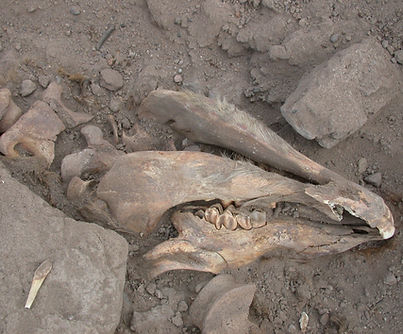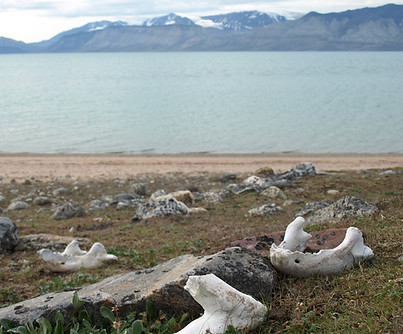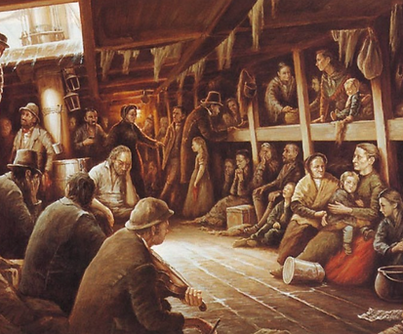Our lab uses chemical techniques (stable isotope analysis) to better understand how humans interacted with their environment in the past. We conduct research all over the world using a variety of isotopic techniques, but our research can be divided into several primary thematic areas listed below.

Animal management practices in Peru and Chile
Stable isotope analysis applied to animal bones, teeth, and other tissues has provided us with tremendous insight into how people managed domestic animals, especially llamas and alpacas in Peru and Chile. We can learn whether animals were local or imported from other regions, and understand how products made from animal products (especially textiles) were exchanged across the landscape.
Representative Publications:
-
Hultquist N, Millaire J-F, Szpak P. 2025 Strontium isotopes and the geographic origins of camelids in the Virú Valley, Peru. Journal of Archaeological Science 174, 106142.
-
Szpak P, Millaire J-F, Chapdelaine C, White CD, Longstaffe FJ, 2020. An Integrated isotopic study of Early Intermediate Period camelid husbandry in the Santa Valley, Perú. Environmental Archaeology, 25, 279-295.
-
Szpak P, Valenzuela D, 2020. Camelid husbandry in the Atacama Desert? A stable isotope study of camelid bone collagen and textiles from the Lluta and Camarones Valleys, northern Chile. PLOS One 15, e0228332.

Historical and palaeoecology of Arctic animals
Using stable isotopes of animal bones and teeth from archaeological sites, palaeontological sites, natural history collections, and recently collected specimens, TEAL members are helping us to better understand how the Arctic environment has changed over the last few thousand years. We particularly focus on the diet, habitat use, and life history of marine and terrestrial mammals.
Representative Publications:
-
Miller MM, Szpak P, Woollett J, 2025. Changes in Inuit hunting practices coinciding with the introduction of firearms in Nunatsiavut: evidence from stable isotope analysis of ringed seals. Philosophical Transactions of the Royal Society B 380, 20240038.
-
Skovrind M, Louis M, Ferguson SH, Glazov DM, Litovka DI, Loseto L, Meschersky IG, Miller MM, Petr M, Postma L, Rozhnov VV, Scott M, Westbury MV, Szpak P, Friesen TM, Lorenzen ED, 2024. Elucidating the sustainability of 700 y of Inuvialuit beluga whale hunting in the Mackenzie River Delta, Northwest Territories, Canada. Proceedings of the National Academy of Sciences 121, e2405993121.
-
Routledge J, Sonne C, Letcher RJ, Dietz R, Szpak P, 2023. Unprecedented shift in Canadian High Arctic polar bear food web unsettles four millennia of stability. Anthropocene 43, 100397.

Agricultural Practices in Peru and Chile
Applying stable isotope analysis to macrobotanicals remains from archaeological sites allows us to understand how people managed their crops, specifically the extent to which they fertilized their plants and whether they provided them with supplemental water through irrigation.
Representative Publications:
-
Styring A, Vaiglova P, Bogaard A, Church MJ, Grocke DR, Larsson M, Liu X, Stroud E, Szpak P, Wallace MP. 2024. Recommendations for stable isotope analysis of charred archaeological crop remains. Frontiers in Environmental Archaeology 3,1470375.
-
Szpak P, Chiou KL, 2020. A comparison of nitrogen isotope compositions of charred and desiccated botanical remains from northern Peru. Vegetation History and Archaeobotany 29, 527-538.

Human Palaeodiet and Palaeomobility
By applying multiple different stable isotope markers, students have assessed the diets of past human populations as well as aspects of their life history, particlarly their likely place of origin. Students have worked on such projects in Peru, Alaska, Turkey, Ontario, and Quebec.
Representative Publications:
-
Hyland C, Millaire J-F, Szpak P, 2021. Migration and maize in the Virú Valley: Understanding life histories through multi-tissue carbon, nitrogen, sulfur, and strontium isotope analyses. American Journal of Physical Anthropology 176, 21-35.
-
Dolphin AE, Teeter MA, Szpak P, 2023. The role of status, diets, and mobility in understanding the impacts of urbanization in early medieval Bergen, Norway (St. Mary's Church): Insights from stable isotope analyses. International Journal of Osteoarchaeology 33, 315-329.

Methodological Studies Related to Archaeological Applications of Stable Isotopes
Our lab makes it a priority to emphasize developing methods that produce the best results with the least amount of sample destruction. We do this by rigorously testing every aspect of our protocols.
Representative Publications:
-
Wilson T, Szpak P. 2023. Comparing the performance of demineralization agents (HCl and EDTA) for stable isotope analysis of bone collagen with implications for quality control criteria and collagen yield 33, 506-516. International Journal of Osteoarchaeology.
-
Hyland C, Scott MB, Routledge J, Szpak P, 2022. Stable Carbon and Nitrogen Isotope Variability of Bone Collagen to Determine the Number of Isotopically Distinct Specimens. Journal of Archaeological Method and Theory 29, 666-686.
-
Wilson T, Szpak P. 2022. Acidification does not alter the stable isotope composition of bone collagen. PeerJ 10, e13593.
-
Wilson T, Szpak P. 2022. Examining the use of ethylenediaminetetraacetic acid for humic extraction of ancient bone. American Journal of Biological Anthropology 179, 148-157.

Understanding Sulfur Isotope Variation
We are still developing our understanding of how sulfur isotopes vary in the environment. They may prove to be a particularly useful tool for studying diet and residential mobility. We are exploring how sulfur isotopes vary in plant and animal tissues so that we can effectively apply these techniques in archaeological contexts.
Representative Publications:
-
Guiry E, Kennedy JR, Stricker L, Lavin M, Szpak P. 2025. What it means to be marine: Sulfur isotope variability in the historical Chesapeake Bay ecosystem. Journal of Archaeological Science 179, 106265.
-
Raoult V, Phillips AA, Nelson J, Niella Y, Skinner C, Tilcock MB, Burke PJ, Szpak P, James WR, Harrod C, 2024. Why aquatic scientists should use sulfur stable isotope ratios (ẟ34S) more often. Chemosphere 355, 141816.
-
Szpak P, Buckley M, 2020. Sulfur isotopes (δ34S) in Arctic marine mammals: indicators of benthic vs. pelagic foraging. Marine Ecology Progress Series 653, 205-216.
